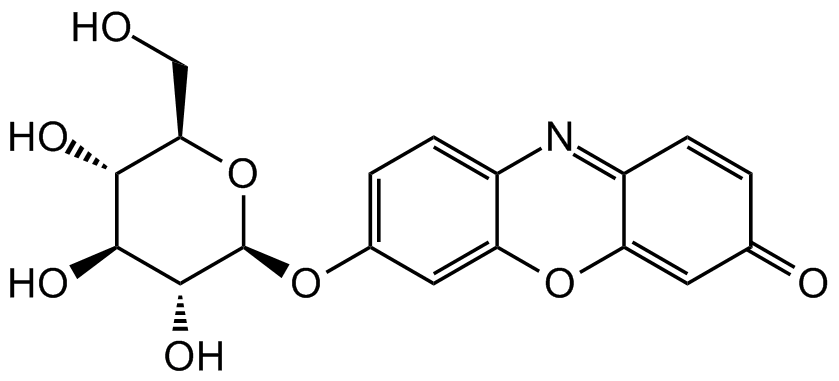Resorufin-beta-D-glucopyranoside
| Code | Size | Price |
|---|
| CDX-R0006-M050 | 50 mg | £266.00 |
Quantity:
Prices exclude any Taxes / VAT
Overview
Regulatory Status: RUO
Shipping:
AMBIENT
Storage:
Short term storage:+4°C. Long term storage:-20°C.
Images
Documents
Further Information
Alternate Names/Synonyms:
3-Phenoxazone 7-(beta-D-glucopyranoside)
Appearance:
Yellow to orange powder.
CAS:
101490-85-1
EClass:
32160000
Form (Short):
solid
Handling Advice:
Protect from light and moisture.
InChi:
InChI=1S/C18H17NO8/c20-7-14-15(22)16(23)17(24)18(27-14)25-9-2-4-11-13(6-9)26-12-5-8(21)1-3-10(12)19-11/h1-6,14-18,20,22-24H,7H2/t14-,15-,16+,17-,18-/m1/s1
InChiKey:
QULZFZMEBOATFS-UYTYNIKBSA-N
Long Description:
Chemical. CAS: 101490-85-1. Formula: C18H17NO8. MW: 375.33. Resorufin-beta-D-glucopyranosid is a non-selective red-fluorogenic substrate. It is a fluorogenic substrate for beta-glucosidase, beta-glucocerebrosidase (GCase) and beta-galactosidase. Upon enzymatic cleavage by the enzymes, the fluorescent hydrolysis product resorufin is released and its fluorescence can be used to quantify enzyme activity. Spectral data of Resorufin: lambdaex=571nm, lambdaem=585nm. It is used in several applications, specifically in compound screens, where it is advantageous because it is less prone to compound autofluorescence, and thus produces less false positives.
MDL:
MFCD00037662
Molecular Formula:
C18H17NO8
Molecular Weight:
375.33
Package Type:
Vial
Product Description:
Resorufin-beta-D-glucopyranosid is a non-selective red-fluorogenic substrate. It is a fluorogenic substrate for beta-glucosidase, beta-glucocerebrosidase (GCase) and beta-galactosidase. Upon enzymatic cleavage by the enzymes, the fluorescent hydrolysis product resorufin is released and its fluorescence can be used to quantify enzyme activity. Spectral data of Resorufin: lambdaex=571nm, lambdaem=585nm. It is used in several applications, specifically in compound screens, where it is advantageous because it is less prone to compound autofluorescence, and thus produces less false positives.
Purity:
>90% (HPLC)
SMILES:
O=C1C=C2OC3=CC(O[C@@H]4O[C@H](CO)[C@@H](O)[C@H](O)[C@H]4O)=CC=C3N=C2C=C1
Solubility Chemicals:
Soluble in DMSO (20 mg/ml). Slightly soluble in water.
Source / Host:
Synthetic
Transportation:
Non-hazardous
UNSPSC Number:
41105331
Use & Stability:
Stable for at least 2 years after receipt when stored at -20°C.
References
(1) O. Motabar, et al.; Anal. Bioanal. Chem. 402, 731 (2012) | (2) S.Ueno, et al.; J. Phtopol. Sci. Technol. 28, 719 (2015) | (3) M.C. Deen, et al.; ACS Chem. Biol. 15, 824 (2020) | (4) A. Gherlein, et al.; Nat. Commun. 14, 2057 (2023)



